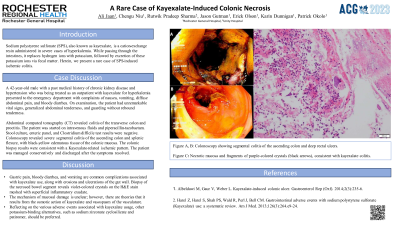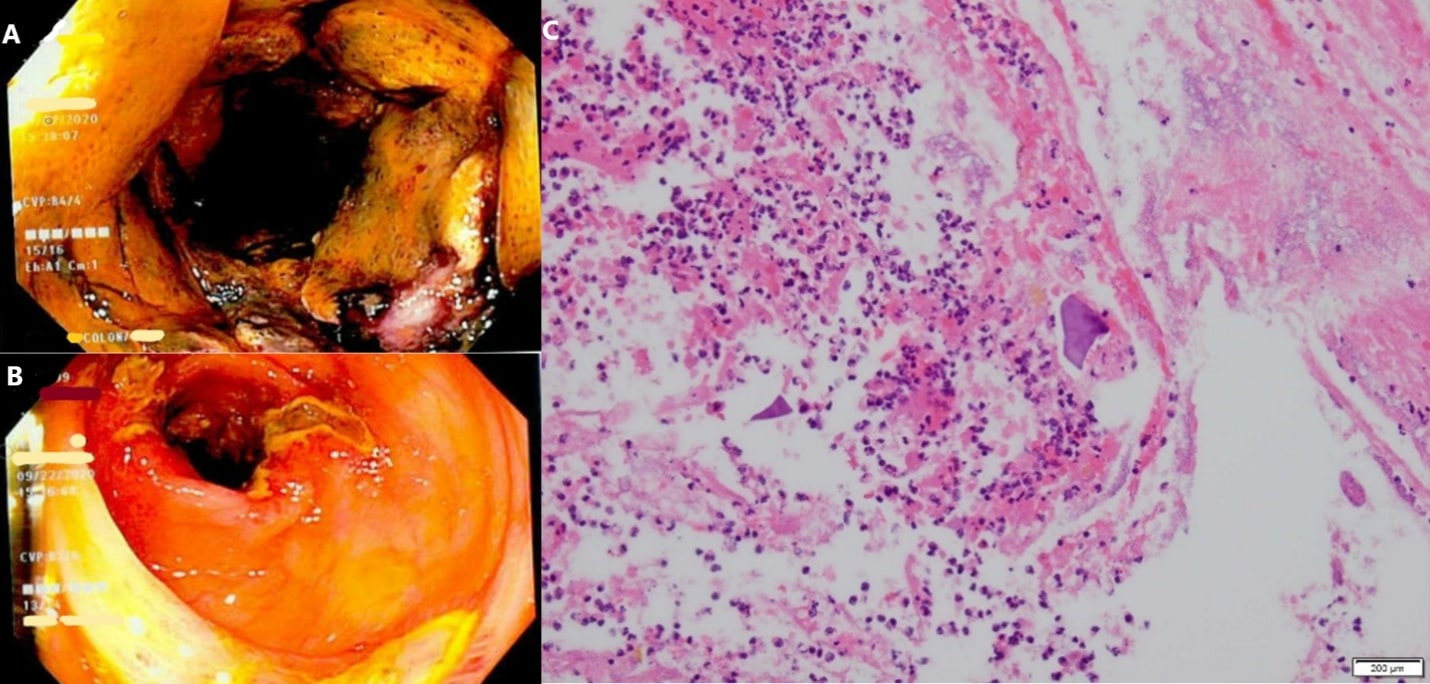Sunday Poster Session
Category: GI Bleeding
P0617 - A Case of Kayexalate-Induced Colonic Necrosis
Sunday, October 22, 2023
3:30 PM - 7:00 PM PT
Location: Exhibit Hall

Has Audio
- AJ
Ali Jaan, MD
Rochester General Hospital
Rochester, NY
Presenting Author(s)
Ali Jaan, MD1, Chengu Niu, MD1, Rutwik Pradeep Sharma, MD2, Jason Gutman, MD1, Erik Olson, DO3, Karin Dunnigan, MD1, Patrick Okolo, MD, MPH, FACG1
1Rochester General Hospital, Rochester, NY; 2Rochester Regional Health / Unity Hospital, Rochester, NY; 3Rochester Regional Health, Rochester, NY
Introduction: Sodium polystyrene sulfonate (SPS), also known as kayexalate, is a cation-exchange resin administered in severe cases of hyperkalemia. When administered orally, it releases sodium and calcium ions in exchange for hydrogen ions upon exposure to the acidic milieu of the stomach. While passing through the intestines, it replaces these hydrogen ions with potassium, followed by excretion of these potassium ions via fecal matter. Herein, we present a case of SPS-induced ischemic colitis.
Case Description/Methods: A 42-year-old male with a past medical history of chronic kidney disease and hypertension who was being treated as an outpatient with kayexalate for hyperkalemia presented to the emergency department with complaints of nausea, vomiting, diffuse abdominal pain, and bloody diarrhea. On examination, the patient had unremarkable vital signs, generalized abdominal tenderness, and guarding without rebound tenderness. Abdominal computed tomography (CT) revealed colitis of the transverse colon and proctitis. The patient was started on intravenous fluids and piperacillin-tazobactam. Stool culture, enteric panel, and Clostridium difficile test results were negative. Colonoscopy revealed severe segmental colitis of the ascending colon and splenic flexure, with black-yellow edematous tissue of the colonic mucosa. The colonic biopsy results were consistent with a Kayexalate-related ischemic pattern. The patient was managed conservatively and discharged after the symptoms resolved.
Discussion: Gastric pain, bloody diarrhea, and vomiting are common complications associated with kayexalate use, along with erosions and ulcerations of the gut wall. Biopsy of the necrosed bowel segment reveals violet-colored crystals on the H&E stain meshed with superficial inflammatory exudate. The mechanism of mucosal damage is unclear; however, there are theories that it results from the osmotic action of kayexalate and vasospasm of the vasculature. Reflecting on the various adverse events associated with kayexalate usage, other potassium-binding alternatives, such as sodium zirconate cyclosilicate and patiromer, should be preferred. Kayexalate might be beneficial in eradicating excess potassium in the body, but physicians should be more cognizant of its use due to its detrimental effects.

Disclosures:
Ali Jaan, MD1, Chengu Niu, MD1, Rutwik Pradeep Sharma, MD2, Jason Gutman, MD1, Erik Olson, DO3, Karin Dunnigan, MD1, Patrick Okolo, MD, MPH, FACG1. P0617 - A Case of Kayexalate-Induced Colonic Necrosis, ACG 2023 Annual Scientific Meeting Abstracts. Vancouver, BC, Canada: American College of Gastroenterology.
1Rochester General Hospital, Rochester, NY; 2Rochester Regional Health / Unity Hospital, Rochester, NY; 3Rochester Regional Health, Rochester, NY
Introduction: Sodium polystyrene sulfonate (SPS), also known as kayexalate, is a cation-exchange resin administered in severe cases of hyperkalemia. When administered orally, it releases sodium and calcium ions in exchange for hydrogen ions upon exposure to the acidic milieu of the stomach. While passing through the intestines, it replaces these hydrogen ions with potassium, followed by excretion of these potassium ions via fecal matter. Herein, we present a case of SPS-induced ischemic colitis.
Case Description/Methods: A 42-year-old male with a past medical history of chronic kidney disease and hypertension who was being treated as an outpatient with kayexalate for hyperkalemia presented to the emergency department with complaints of nausea, vomiting, diffuse abdominal pain, and bloody diarrhea. On examination, the patient had unremarkable vital signs, generalized abdominal tenderness, and guarding without rebound tenderness. Abdominal computed tomography (CT) revealed colitis of the transverse colon and proctitis. The patient was started on intravenous fluids and piperacillin-tazobactam. Stool culture, enteric panel, and Clostridium difficile test results were negative. Colonoscopy revealed severe segmental colitis of the ascending colon and splenic flexure, with black-yellow edematous tissue of the colonic mucosa. The colonic biopsy results were consistent with a Kayexalate-related ischemic pattern. The patient was managed conservatively and discharged after the symptoms resolved.
Discussion: Gastric pain, bloody diarrhea, and vomiting are common complications associated with kayexalate use, along with erosions and ulcerations of the gut wall. Biopsy of the necrosed bowel segment reveals violet-colored crystals on the H&E stain meshed with superficial inflammatory exudate. The mechanism of mucosal damage is unclear; however, there are theories that it results from the osmotic action of kayexalate and vasospasm of the vasculature. Reflecting on the various adverse events associated with kayexalate usage, other potassium-binding alternatives, such as sodium zirconate cyclosilicate and patiromer, should be preferred. Kayexalate might be beneficial in eradicating excess potassium in the body, but physicians should be more cognizant of its use due to its detrimental effects.

Figure: Figure A, B: Colonoscopy showing segmental colitis of the ascending colon and deep rectal ulcers. C: Necrotic mucosa and fragments of purple-colored crystals (black arrows), consistent with kayexalate colitis.
Disclosures:
Ali Jaan indicated no relevant financial relationships.
Chengu Niu indicated no relevant financial relationships.
Rutwik Pradeep Sharma indicated no relevant financial relationships.
Jason Gutman indicated no relevant financial relationships.
Erik Olson indicated no relevant financial relationships.
Karin Dunnigan indicated no relevant financial relationships.
Patrick Okolo indicated no relevant financial relationships.
Ali Jaan, MD1, Chengu Niu, MD1, Rutwik Pradeep Sharma, MD2, Jason Gutman, MD1, Erik Olson, DO3, Karin Dunnigan, MD1, Patrick Okolo, MD, MPH, FACG1. P0617 - A Case of Kayexalate-Induced Colonic Necrosis, ACG 2023 Annual Scientific Meeting Abstracts. Vancouver, BC, Canada: American College of Gastroenterology.
